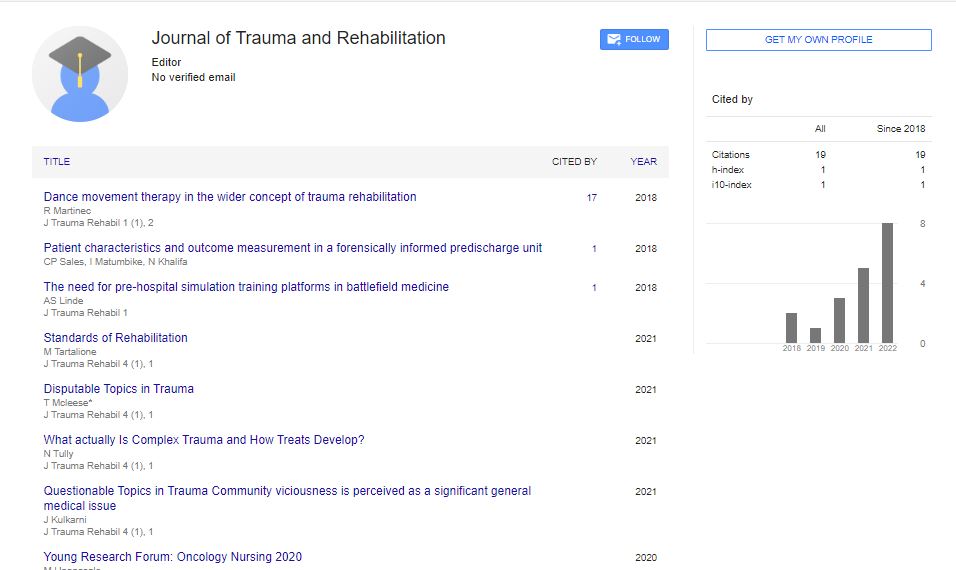Perspective, J Trauma Rehabil Vol: 6 Issue: 2
Orthopedic Trauma: Strategies for Prevention and Preparedness
Christopher Trompeter*
1Department of Orthopaedic Surgery, University of Missouri, Missouri, Columbia
*Corresponding Author: Christopher Trompeter,
Department of Orthopaedic
Surgery, University of Missouri, Missouri, Columbia
E-mail: tr.christopher44@gmail.com
Received date: 29 May, 2023, Manuscript No. JTR-23-106883;
Editor assigned date: 31 May, 2023, PreQC No. JTR-23-106883 (PQ);
Reviewed date: 14 June, 2023, QC No. JTR-23-106883;
Revised date: 21 June, 2023, Manuscript No. JTR-23-106883 (R);
Published date: 28 June, 2023, DOI: 10.4172/Jtr.1000125
Citation: Trompeter C (2023) Orthopedic Trauma: Strategies for Prevention and Preparedness. J Trauma Rehabil 6:2.
Description
Orthopedic trauma, involving injuries to bones, joints, and soft tissues, can occur due to accidents, falls, sports-related incidents, and other sudden events. While effective management and treatment are essential for recovery, prevention and preparedness play a cral role in reducing the incidence of orthopedic trauma and mitigating its impact when it does occur.
Prevention strategies
Preventing orthopedic trauma is paramount in promoting public health and reducing the burden of injuries. Implementing various prevention strategies can significantly reduce the risk of accidents and related injuries:
Safety education: Public education campaigns on safety practices, such as proper body mechanics, safe driving, and using protective gear during sports and recreational activities, can raise awareness and promote injury prevention.
Workplace safety: Employers should prioritize workplace safety by implementing safety protocols, providing proper training for employees, and ensuring a hazard-free environment.
Fall prevention: Older adults are particularly vulnerable to falls, which can lead to severe orthopedic injuries. Implementing fall prevention programs, modifying the home environment, and encouraging regular exercise can help reduce fall-related injuries.
Child safety measures: Installing safety gates, securing furniture, and using childproof locks can help prevent falls and injuries in young children.
Road safety: Strict enforcement of traffic rules, including wearing seat belts and helmets, can significantly reduce the number and severity of orthopedic injuries resulting from road accidents.
Sports injury prevention: Coaches and athletes should adhere to proper training techniques, warm-up exercises, and use of protective equipment to minimize the risk of sports-related injuries.
Home safety checks: Regular home safety assessments can help identify potential hazards and address them promptly to prevent accidents.
Emergency preparedness
Despite preventive efforts, accidents can still happen. Being prepared to respond quickly and efficiently to orthopedic trauma is essential for minimizing the impact of injuries:
Emergency contact information: Keep a list of emergency contact numbers, including local emergency services, nearby hospitals, and contacts of family members or friends who can provide assistance.
First aid training: Acquiring basic first aid training can equip individuals with essential skills to administer immediate care until professional medical help arrives.
First aid kit: Have a well-stocked first aid kit readily available at home, in the car, and at sports venues. The kit should include bandages, antiseptic wipes, pain relievers, and other essential supplies.
Emergency action plan: Organizations, schools, and sports facilities should have a clear and practiced emergency action plan in place to respond effectively to orthopedic trauma and other medical emergencies.
Transport and evacuation: Establish protocols for safe transportation and evacuation of injured individuals to medical facilities. Immobilization of injured limbs can help prevent further damage during transport.
Coordination with emergency services: Foster collaboration with local emergency services to ensure prompt response and smooth coordination during emergencies.
Safety gear and equipment
Appropriate safety gear and equipment can significantly reduce the risk and severity of orthopedic trauma in various settings:
Sports and recreation: Wearing helmets, knee and elbow pads, mouthguards, and appropriate footwear can protect athletes and recreational participants from injuries.
Workplace: Depending on the job, workers should use personal protective equipment, such as hard hats, safety goggles, and gloves, to minimize the risk of injuries.
Child safety: Use safety gates, window guards, and secure furniture to prevent falls and other accidents in households with young children.
Regular health checkups
Regular health checkups can help identify pre-existing conditions or risk factors that may contribute to orthopedic trauma. Conditions such as osteoporosis, osteoarthritis, and balance disorders can increase the likelihood of fractures and falls. Early detection and appropriate management can help prevent injuries or minimize their severity.
Community awareness and advocacy
Community-wide efforts are instrumental in promoting orthopedic trauma prevention and preparedness:
Community programs: Local organizations and healthcare providers can organize educational programs, safety workshops, and community events to raise awareness of injury prevention.
Advocacy: Advocate for policies and regulations that promote safety in public spaces, schools, workplaces, and recreational areas.
Conclusion
Orthopedic trauma can lead to significant morbidity and impact an individual's quality of life. By prioritizing prevention strategies and preparedness measures, one can significantly reduce the incidence and severity of orthopedic injuries. Public education, workplace safety measures, fall prevention programs, and appropriate use of safety gear can contribute to a safer environment for everyone. In the event of an accident, being prepared to respond quickly with first aid and access to emergency services can make a vitalal difference in minimizing the long-term effects of orthopedic trauma. By combining preventive efforts with preparedness measures, one can work towards a society where orthopedic trauma is less common and its impact is effectively managed.
 Spanish
Spanish  Chinese
Chinese  Russian
Russian  German
German  French
French  Japanese
Japanese  Portuguese
Portuguese  Hindi
Hindi 